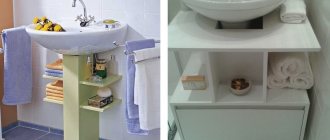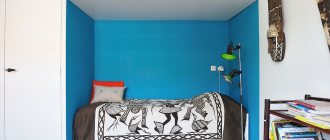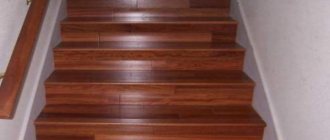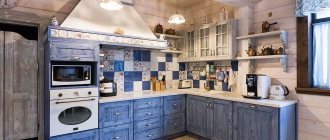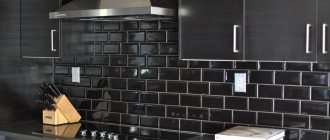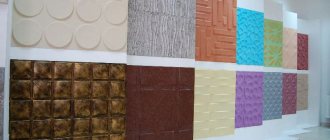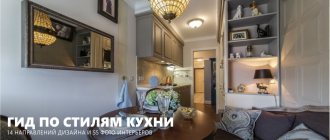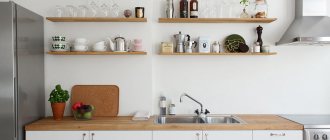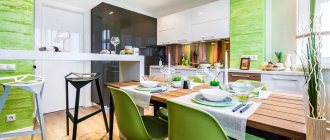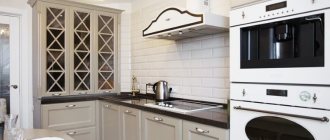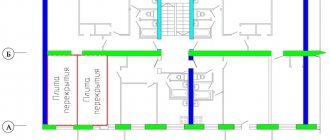Laminate has been successfully used as a floor covering for many years. However, an interesting and unexpected solution could be its use when decorating the walls in the kitchen.
Using laminate boards you can create unique interiors
Finishing kitchen walls with laminated panels has a number of advantages:
- aesthetics - manufacturers offer a wide range of materials of different textures, colors, shades; There are stunningly spectacular options with imitation wood and stone;
- practicality - it is a strong and durable material with proper care; Contaminants, including food, are easily removed from its surface;
- ease of installation - installation of laminated surfaces on walls is possible in several ways, and can be easily done at home on your own;
- economy - considering that, when placed on the wall, the panel will not experience the same loads that the floor covering is subjected to, you can choose a budget option - thin laminate.
Laminate is much stronger than PVC and MDF panels; such finishing will not break if hit.
What is special about laminate walls?
The use of laminate as a finishing material for walls in the kitchen is dictated by its main advantages. These include:
- ease of installation. Even novice craftsmen can perform the entire complex of work;
- availability. In terms of cost, laminated boards are significantly inferior to solid wood panels and parquet boards;
- wear resistance. A material of a suitable class resists external influences well. The formed coating retains its presentable appearance for a long time;
- soundproofing properties. Walls lined with laminate better protect the interior from external noise;
- the ability to select panels with improved characteristics that are not afraid of exposure to high temperatures, high humidity and shocks;
- a large assortment. You can choose boards of a suitable color and with the desired texture;
- possibility of zoning space. Laminated panels help place accents and attract attention;
- ease of care.
Although laminated boards have many advantages, when choosing this method of finishing walls in the kitchen, you need to remember that:
- prolonged contact with water and prolonged exposure to high humidity reduce the service life of the panels and deteriorate their appearance;
- Careful leveling of the base may be required;
- the possibility of using the material to decorate a small area of wall.
Which laminate is better to choose?
In many respects (wear resistance, moisture resistance), kitchen laminate is inferior to tiles or porcelain stoneware. But this does not mean that it is better to choose tiles: high-quality laminate flooring will last at least 10 years, so there is nothing to be afraid of. The main thing is to learn how to choose the right laminate for your kitchen.
The first difference is the class of the laminate. The higher it is, the more severe the impact the surface can withstand. Class 34 has the highest abrasion resistance; it is even laid in hotel lobbies or cafeterias. Manufacturers coat almost all models of this laminate with a water-repellent composition, which makes class 34 an excellent choice for the kitchen.
Important! The moisture-resistant laminate for the kitchen is marked waterproof, aqua protect. Or drawings in the form of a drop of water, a mixer.
What characteristics should you pay attention to when choosing?
When starting to choose a suitable model, you should decide on the purpose of the purchase. If you need to disguise crumbling plaster, you should choose rigid panels of any type. If you want to update your interior, you should consider that:
- boards with a lock that allows changes in the position of the coating relative to the base will cause problems during the installation process;
- panels of different colors with visually identical locks may not connect to each other during the installation process. This will cause unwanted gaps to appear. To avoid this, lock compatibility should be checked upon purchase;
- a laminate with the highest possible moisture resistance class is preferable, since in the kitchen the humidity level is always higher;
- the thicker the panels, the smaller the internal space will become, and the outer edge will be more difficult to decorate;
Attention! Laminate should not be used to decorate the apron. Ceramic tiles or glass are best suited for this area.
Installing heated floors under laminate
A question that interests many is whether it is possible to lay laminate flooring on a heated floor.
Laminate itself is warm, but you can insulate it additionally
Experts assure that this can be done, but you need to take into account some features of the coating:
- Electric heated floors are not suitable for you. Due to the fact that the film heats up quickly and not always evenly, over time the laminate can become deformed and dry out. The optimal solution would be hydronic or infrared heated floors.
- Laminate does not tolerate sudden temperature changes, so you will have to gradually increase the heating level of the heated floor. In order to avoid damage to the floor, install temperature sensors and use a rheostat, which will allow the room to be heated gradually.
- Make sure that the floor does not heat above 28 degrees - otherwise it will become too fragile and brittle.
- When using heated floors, we recommend turning on special air humidifiers. Do not allow the humidity in the kitchen to drop below 50%. This is fraught with drying out of the laminate and, as a result, the appearance of cracks.
Comparison with wallpaper
Manufacturers offer a large number of wallpapers that differ from each other not only in appearance, but also in technical characteristics. Roll materials have a presentable appearance. Presented in a large assortment. Manufacturers offer canvases that imitate various natural materials, including wood. However, in terms of their characteristics, they are significantly inferior to laminate. They cannot be used to create an apron, since the material is not able to resist fire and moisture. Washable models allow for periodic cleaning. However, only some of them allow the use of detergents.
Laminated boards can be washed multiple times. Contaminants that appear on their surface are more easily removed. Manufacturers offer a large number of detergents designed specifically for cleaning laminated surfaces. Using them makes it easier to remove settled dirt. As a result, the formed surface retains its original appearance longer.
Comparison with tiles
Ceramic tiles are a sought-after and popular material when decorating kitchen walls. Most often, it is used to design a work area. The material is not afraid of exposure to fire and moisture, which makes it a popular option when decorating an apron. However, the use of tiles when decorating a dining area is limited.
Laminate allows you to beautifully decorate the area adjacent to the dining group. The surface looks beautiful. In addition, you can also use it to decorate your apron beautifully. To do this, instead of conventional panels, you need to choose a moisture-resistant version, which will retain its geometry and properties even during prolonged use in conditions of high humidity. Due to this, you can beautifully decorate all the walls in the kitchen. In addition, the cost of laminated boards is often lower than ceramic tiles.
What is laminate
The material itself is a thin high-density fiberboard. Wood fibers are pressed using high temperatures, achieving the tightest possible fit and adhesion of the constituent elements.
Laminate is a multi-layer coating
The top layer of the slab is covered with a special wear-resistant film, which simultaneously performs protective and decorative functions.
Thanks to this technology, durable and beautiful blocks are obtained that are well suited for use in the kitchen.
Kinds
There are two main types of laminated boards used to decorate walls. They differ in installation method and design. When choosing a suitable variety, it is worth comparing its advantages and disadvantages. This will allow you to make a choice in favor of a suitable variety.
Sheet piling
Such panels have complex geometry. Special locks are used to connect individual panels. As a result, a continuous coating is formed, in which one board is securely connected to another. When installed correctly, the result is a perfectly flat surface, even if the base has not been properly prepared.
pros
- availability;
- large assortment of colors, sizes, textures;
- ease of installation;
- high wear resistance;
- thermal insulation and noise insulation properties;
- presentable appearance;
- ease of care;
- durability;
- environmental friendliness.
Minuses
- sensitivity to the effects of abrasive of certain models;
- insufficient level of protection from moisture;
- demands on the quality of the installation performed;
- low repairability of the damaged top layer;
- change in geometric parameters with temperature fluctuations.
Adhesive
This category includes elastic two-layer vinyl panels. The top layer provides protection from external influences. The bottom one is the main one. The absence of a locking connection simplifies installation work. With its help you can beautifully decorate an uneven surface. In this case, a fairly durable and flexible coating is formed. To fix the panels to the wall, liquid nails are mainly used.
pros
- Water resistance;
- Wear resistance;
- Absence of harmful substances;
- Fire resistance;
- Possibility of partial repair of the coating;
- Aesthetics;
- Attractiveness;
- Lack of sensitivity to temperature fluctuations.
Minuses
- Sensitivity to ultraviolet light;
- Loss of color upon contact with rubber elements;
- Environmentally hazardous production;
- High price.
Ceiling decoration
Many designers are trying to transform the gray and dull style of the room into something lighter and more modern in nature.
One of the tricks that helps them do this is to place laminate flooring on the kitchen ceiling. Every day this method is gaining more and more popularity, but you need to understand that the process itself is quite lengthy and complex in principle. Ultimately, you can get not only a spectacular interior, but also additional sound insulation of the ceiling.
Installation of the planks is carried out on a pre-prepared sheathing using self-tapping screws. The cost of decorating a ceiling with laminate can sometimes be identical to finishing with plasterboard. For work, it is quite possible to choose thin planks with the lowest strength class, since there will be no loads or external influences on it.
Stylists and decorators use this technique to achieve solutions to all kinds of design problems and ideas. Often the decor at the bottom of the wall is extended and “led” onto the ceiling, which allows you to visually highlight a separate area in the kitchen. Typically, such finishing is used for high rooms, since installing planks will, at a minimum, take about 100 mm of space and make it smaller.
Examples in design
Using laminate you can decorate the walls in the kitchen in different ways. Boards can be positioned vertically, horizontally and diagonally. Each variant deserves special attention. Horizontally placed boards visually expand the space.
Vertical boards visually “raise” the ceiling and help to correctly place accents in the room. It is not necessary to decorate the entire wall in this way. You can select a separate zone to attract attention.
Instead of strictly horizontal or vertical rows, other options are possible. Thanks to this, it is possible to design the surface differently.
In addition to the spatial arrangement of individual panels, the color scheme deserves attention. When choosing, the overall design of the room and style are taken into account.
An interesting option are contrasting solutions. A dark laminate is matched to a light set and vice versa.
Multi-colored boards forming a melange coating look original.
We invite you to get acquainted with other, no less original options for interior design in the kitchen using laminate. Some of them can be safely taken as an idea for subsequent implementation.
Design options
Finishing a wall with laminate is a non-standard solution for the kitchen. A kitchen apron with wooden paneling performs a protective function and acts as a decorative element. Moisture-resistant types (floor and laminated hardboard) allow you to accomplish your plans without encountering the unpleasant consequence of deformation. If you play with color and decorate the wall in contrast with other finishing materials, you will be able to differentiate the cooking and eating areas.
White
Whitened laminate in a cool shade is an excellent solution for small kitchens. He gives them freshness, neatness, and emphasized cleanliness. With it they gain airiness and spaciousness.
Caring for a bleached board is simple, like any other: the dirt is washed off with a rag soaked in water and detergent.
Black
Glossy high-tech is the choice of young married couples who are setting up a cozy nest for the first time. A style of design and architecture that originated in the 60s. XX century, presupposes the presence of modern equipment in the kitchen. To emphasize its modernity, you cannot do without walls decorated using black laminate. The “neighborhood” of technology and this finishing material enlivens the interior and warms on chilly autumn and spring days.
Grey
If you decorate the interior in bright blue (or you bought furniture in this color for the kitchen), then gray panels will neutralize its strength. The idea is a losing one if the kitchen is small and there are no mirrors or glass surfaces.
Yellow, red, green
Laminate flooring, painted in such bright and rich colors, looks advantageous against the background of snow-white cabinets and walls. If there is a small pattern on it, you will get an interesting visual effect. If to decorate the kitchen in an apartment they choose a minimalist style (the apron above the work area is decorated with a laminate laid in a herringbone pattern) and are content with that, then in dachas and country houses they are experimenting. For the kitchen they buy a single-level U- or L-shaped set. In the first case, a fireplace (including a decorative one) is placed near a free wall and covered with laminate. In the second case, the corner between two walls trimmed with laminated wood panels will be highlighted. To prevent them from looking pretentious, lay laminate flooring in the same color or buy furniture in the same color scheme.
Designers combine boldness and practicality in one extravagant solution. They finish all surfaces, including walls and ceilings, with the same type and color of laminate. It will be everywhere: above, below, on the walls. By experimenting with the color of the decor and kitchen furniture, you avoid “draining” the space.
DIY installation features
The installation procedure for laminate flooring may vary. Depends on the type of boards chosen. When choosing an adhesive method, it should be taken into account that the geometric parameters of the laminate may change depending on the ambient temperature. When the temperature rises or humidity changes, the slats may fall off the base. To prevent this from happening, you must use a suitable adhesive composition. Most often, liquid nails are used to fix the laminate to the wall, forming a strong and at the same time durable connection. Installation work is carried out in the following sequence:
- The base is leveled;
- The wall is primed and degreased;
- The laminate is glued.
Installation starts from the lower left corner. The panels are placed vertically or horizontally. There are small gaps around the perimeter for installing special corners. To form a strong connection, you need to consider that:
- It is better to apply the glue in a zigzag pattern;
- The space between the panels should be filled with sealant to exclude dirt and moisture under the laminate;
- If the finishing area is small, the boards are connected to each other on the floor, and then the assembled structure is mounted on the wall.
If it is quite difficult to level the wall surface, you can fix the panels to the sheathing. In this case, installation work becomes somewhat more complicated, but you can avoid carefully preparing the base. In addition, the lathing can be used for hidden wiring. Installation is carried out in the following sequence:
- Preparation of bars of the required size depending on the length and width of the laminate;
- Assembly and installation of sheathing;
- Fastening the panels to the sheathing with clamps. For greater reliability, you can additionally use an adhesive composition.
Attention! If the partition in the kitchen is covered with plasterboard, you should refuse to install laminate. The base may not support the weight of the decorative trim.
We invite you to watch the video to become better acquainted with the procedure for installing laminate flooring on a wall:
Types of laminated coatings
Modern technologies offer on the market several types of laminated coatings with similar properties. Let's look at them in detail:
- MDF panel. They are distinguished by their low price and ease of installation to all types of lathing. The main disadvantage of the product is that its laminated surface is ordinary varnished paper. Therefore, the material is hygroscopic;
- Chipboard. No lathing is required at all. In addition, the laminated surface of the product is denser, which has a positive effect on its strength. The main disadvantage, again, is the hygroscopicity of the material;
- HDF laminate or laminated hardboard. It is a compressed material. It has good density, which allows it to be used as a protective apron in the kitchen;
- Laminate flooring. An ordinary floor covering used as a kitchen apron will do an excellent job with its responsibilities.
DIY installation options are divided into two types:
- Glue or liquid nails. Installation is carried out on a flat base without the use of plaster;
- Lathing. A structure made of slats or blocks on which the material is laid.
Depending on the installation method:
Glue. With this installation method, adhesion to the base will be insufficient, so this installation option on the lathing is not recommended.
Tongue and pile. Using nails or staples, the structure is mounted on glue and wooden sheathing, and fixed in a similar way to clapboard.
Clicky. More reliable fastening than tongue and groove. This will securely attach the adhesive to the sheathing. Small nails are used for additional fixation.
Chipboard and MDF
You need 4 to 6 holes in the wall. Plastic dowels together with long screws will securely secure the product. We will cover the ends with a special profile for the edge. It is better to seal it with sealant.
This way not only fixes the material, but also provides additional protection from water. Special fasteners for the mirror will allow you to hide the caps from the screws. MDF panels are fastened in a similar way. Unlike laminated chipboard, the ends of the panels are already laminated .
HDF
It is more difficult to make a kitchen apron from this type of laminate on the wall. We install a more frequent sheathing of 2x4 cm slats. Treat it with drying oil and let it dry completely. This will help her fight moisture. We fix it on the wall.
A perfectly flat surface is not required. The design will completely hide all the imperfections of the wall. The grid cell is mounted no more than 30 cm. The recommended method of fastening and edging is using liquid nails. Despite the frequency of lathing, less material is required than for other materials.
Laminate flooring
Conventional laminate is installed not only above the work area, but also, if desired, over the entire area. We take a laminated panel and attach it vertically in one row. The combination of a dark wood-like bottom with a light top has proven itself very well in practice.
We fasten the sheathing using liquid nails. The use of locks, screws and nails is not possible. This design is necessary when the surface covering is longer than the length of the board. With a perfectly flat base, the material is installed without lathing.
If there are irregularities, the sheathing becomes horizontal, in the form of four rows of slats, the thickness of which is no more than 25 mm. The edging is finished with a corner made of plastic or aluminum.
Care
In order for laminate flooring to maintain its presentable appearance for a long time, it must be properly cared for. You should:
- Wipe the surface daily to remove any stains that appear;
- wash the surface once a week;
- prevent the possibility of excessive humidification or drying of the air in the kitchen;
- use special compositions for cleaning, when developing which manufacturers took into account the characteristics of the laminated surface;
- follow the dosage recommended by the manufacturer;
- treat the surface with special wax and other means that increase its shine and reduce the adhesion of dirt;
- promptly repair scratches that appear on the surface with a special wax pencil.
Thus, laminate on the kitchen wall allows you to zone the space and can be an ideal option for any stylistic direction. The material has its advantages and disadvantages. By comparing them with each other, you can decide on the advisability of decorating the walls in your home. If necessary, the entire scope of installation work can be completed in-house.
Decorating walls in the kitchen with laminate: choice of material
This material comes in a variety of types, textures and colors.
Which one can be attached?
The same option that is used for finishing the floor is suitable. But since the pressure on the material located on the walls is less, thinner panels with low wear resistance are selected. You can choose models with both types of fastening: Lock and Click.
Which one should not be mounted on the walls in the kitchen?
You should not use models without a special moisture-resistant coating if you want the finish to last for many years.

